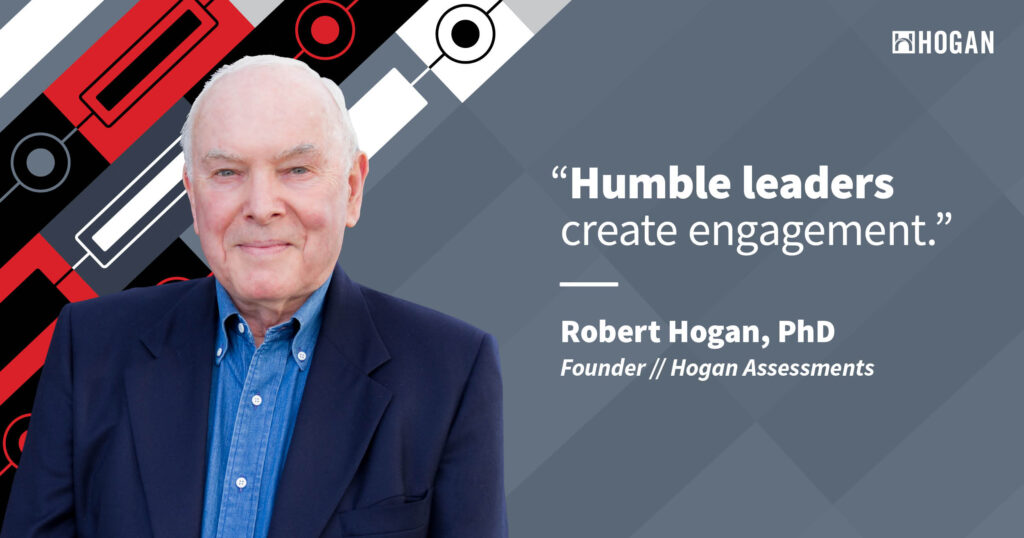
“Humble leaders create engagement,” said Robert Hogan, PhD, founder and president of Hogan Assessments.
Humility is a complex characteristic to translate into behavior. Sometimes the word humility is even used as a generalization for meekness or deference. Instead of humility, most people are likely to think of charisma as an essential trait in engaging leaders. Although charismatic people may often sit in leadership roles, humble people are more effective at the task of leading.1
Humble leaders create engagement by building trust with others through their actions. By drawing a clear line linking humility and engagement, Dr. Hogan underscored the importance of leader behavior and employee trust. It takes a humble person to build and maintain a high-performing team—someone who listens to feedback, shares credit, takes responsibility, and focuses on advancing organizational goals, rather than personal goals.
Read on to learn more about the connection between humility and coachability, why trust is a pillar of engagement, and how leaders can develop humility.
What Is Humility?
Humility is an aspect of personality that concerns whether a person is likely to accept feedback and learn from mistakes.
Coachability
How we tend to respond to growth and learning experiences affects how others interpret our behavior. People who seem self-accepting, kind, and modest about their work are viewed as humble. In contrast, people who seem overly self-confident, stubborn, and unwilling to acknowledge their faults are viewed as arrogant. Put another way, humility relates to feedback receptivity, and arrogance relates to feedback resistance.
Dr. Hogan describes the feedback component of humility as coachability. “Humility is all about being coachable. It’s about being able to admit you made a mistake and learn from experience,” he said. The highest-performing athletes are not only talented. They are also willing to listen to feedback and refine their performance. Unsurprisingly, the highest-performing leaders show the same qualities: talent and coachability.
Self-Confidence
Humility is different from weakness or low self-confidence. Humble people tend to acknowledge their limitations, spotlight others’ contributions, and listen to and learn from others. Their egalitarian values make them likely to consider alternate viewpoints, which can result in better decision-making. Their awareness of their limits makes them likely to delegate successfully.
“Humility is not about lacking self-confidence,” said Dr. Hogan. “Self-confident and humble is the proper combination for effective leadership.”
Humble leaders often demonstrate unassuming confidence, show assertiveness, and set forth a clear vision for the organization. More than 15 years of research about effective business leaders show that they combine “extreme personal humility with intense professional will.”2 Such leaders are driven to improve performance, both theirs and their teams’. They exert their energy on behalf of the group, not for their individual gain. This behavior earns trust.
Humble Leaders Build Trust; Trust Builds Engagement
“People who seem humble are also trustworthy,” Dr. Hogan said. Trust, however, seems to be a scarce commodity in the workplace. In the US, only 21 percent of employees strongly agree that they trust the leadership of their organization.3 Anecdotally, 65 to 75 percent of leaders fail, suggesting that comparatively few leaders demonstrate humility.1 “Humble leaders listen to feedback, admit their mistakes, and delegate properly—and that creates engagement. Trust is the principal factor in engagement,” he continued.
Globally, only 23 percent of employees are engaged at work.4 “When engagement’s up, all the good things happen; when engagement’s down, all the bad things happen,” Dr. Hogan quipped. He called engagement a critical factor in team productivity, as well as an accurate predictor of significant business outcomes. Engagement is certainly tied to revenue; the low engagement or active disengagement of 77 percent of global workers costs the global economy an estimated 8.8 trillion US dollars.4
Organizations that value charisma above capability often overlook their most effective leaders. Some of the most wildly successful CEOs of all time were “modest and humble, as opposed to self-dramatizing and self-promoting.”1 Leading with humility yields intrapersonal, interpersonal, and organizational profits, as reflected in the stock prices of companies led by humble people.2
How Leaders Can Develop Humility
Humble leaders seek feedback and continual improvement. “Humility allows leaders to stop making repeatable mistakes,” said Dr. Hogan.
Leadership development goals that focus on building humility include acknowledging mistakes and asking for and listening to feedback. Actively recognizing others’ achievements, understanding one’s own limitations, and monitoring self-promoting behaviors are also extremely important. A qualified Hogan coach can be an invaluable asset to a leader who is working to earn trust from others.
“The first step for a leader to develop humility is to acknowledge that you’re not very humble. You need to understand that without it, you’re going to fail,” Dr. Hogan said. Someone who utterly refuses to learn from experience will likely develop a reputation for poor judgment and have difficulty retaining followers.
The actions of humble leaders are focused outward. Humble leaders seek to improve team performance, not just individual performance. They channel their ambition back into the organization, rather than toward themselves. They build a culture of psychological safety based on trust, openness, and recognition. And by modeling behavior, they foster a culture of development and encourage learning and growth.
References
- Hogan, R., & Kaiser, R. B. (2005). What We Know About Leadership. Review of General Psychology, 9(2), 169–180. https://doi.org/10.1037/1089-2680.9.2.169
- Collins, J. (2001). Good to Great. Harper Business.
- McLain, D., & Pendell, R. (2023, April 17). Why Trust in Leaders Is Faltering and How to Gain It Back. Gallup. https://www.gallup.com/workplace/473738/why-trust-leaders-faltering-gain-back.aspx
- State of the Global Workplace. (2023). Gallup. https://www.gallup.com/workplace/349484/state-of-the-global-workplace.aspx